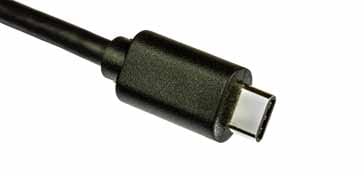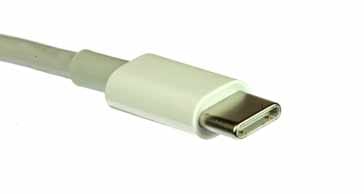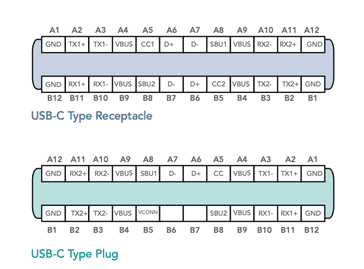What is USB-C
USB-C or USB Type-C is a 24 pin USB connector system which was introduced in August 2014 to provide increased connectivity and smaller more robust connector.
USB Universal Serial Bus Includes:
USB introduction
USB standards
Connectors, pinouts & cables
Data transfer & protocol
USB 3
USB-C
USB hubs
How to buy best USB hub
The USB C or more correctly the USB Type-C connector provides many advantages over its predecessors. Providing improved connectivity, and robustness it is making a major introduction into the market.
The USB Type-C or USB-C connector itself can support new USB capabilities like USB 3.1, USB 3.2 and now USB 4. As part of this, USB C also supports the improved USB Power Delivery, USB PD capabilities. Indeed its development has been closely linked with the introduction of the USB 3 and later standards. In fact the USB Type-C is used with USB3, i.e. USB 3.0, 3.1, 3.2, etc,
The standard USB connector used on items like flash memory cards and many computer connections of the Type-A, and there are other types as well that are used for camera connectors, smartphones and the like, but the type-A connector has remained the same for very many years.
USB-C has been adopted for a huge number of devices from smartphones and tablets to computer laptops and beyond. Even the Apple lightning connector may be replaced, at least on smartphones for Europe.
What is USB-C
USB Type-C connector is the new smaller connector standard for USB. It is about a third the size of the old type-A connectors.
The other advantage of the USB-C connector is that it is a single connector standard that can be used for all devices, so the proliferation of different connectors should reduce as USB-C becomes more widespread.
There has been a significant amount of development invested in the USB-C and it is considerably more flexible than previous iterations. It can be used for connections to low power devices like smartphones, cameras and the like, or it can be used for computers and laptops.
In fact the USB-C connector is considerably more robust than the USB mini and USB micro connectors that were widespread before.

The USB-C connector has some similarities to a micro USB connector, although it is more oval-shaped and slightly thicker. Like the Lightning and MagSafe connectors, the USB-C connector has no up or down orientation. Line up the connector properly, and you don't have to flip it to plug it in.
The other difference is that the same USB-C connector is used at both ends of a cable, i.e. it is reversible. Thee is no need to differentiate between upstream and downstream connectors as was needed for USB 2 with its A and B connectors. The USB 3 standards provide the protection needed if two power sources are plugged together.
USB-C ports are considerably more flexible than their predecessors. The USB-C is able to support a variety of different protocols using what may be termed alternate modes. This allows the ability to have adapters that can output HDMI, VGA, DisplayPort, or other types of connections from that single USB port.
This provides a considerable level of convenience because the variety of USB, HDMI, DisplayPort, VGA, and power ports on typical laptops can be converged into the use of a single type of port. The USB-C / USB 3 is able to support other interfaces in a mode known as Alternate mode.
With many laptop manufacturers like Apple reducing the number of interface connectors on their laptops to a minimum to make them look more elegant by making them much more slim as well as reducing costs, etc, providing even just two USB-C connectors gives sufficient capability when using an additional hub to give all the connectivity that is required.
USB-Type C and USB3.1
The new USB-C connector is also capable of carrying the very much higher data speeds that are now available with USB3 / USB3.1.
With data speeds from a variety of sources increasing, and with the possibility of using USB-C for HDMI and other capabilities, the connector must be capable of supporting data rates of these speeds.
With USB 3.1 providing data transfer rates of 5Gbps, these speeds are commensurate with frequencies well into the microwave region.

USB C connector pinout and functions
The USB C Type connector has a much larger number of lines that are available to provide the increased capability.
The connectors have 24 pins and unlike USB1 and USB2, the connector can be plugged in either way up, although when used alongside a USB 1 / USB2 xconnection it is possible the connector may need to be flipped.
The diagram below shows the USB-C pinout for both the receptacle, i.e. socket, and also the plug.

The individual lines within the USB-C connector all have different functions.
CC1 & CC2: CC stands for channel configuration, and these lines perform many of the configuration functions required by the port / cable including detection of cable attachment / removal, receptacle/plug orientation detection, and current advertisement. These lines are also used for the communication and configuration required for USB-PD and Alternate Mode where the USB connection is required for interface to other interface standards like HDMI, etc.
D+ & D- : The D+ and D- lines provide the differential pairs for USB 2 connectivity. It can be seen that there are two sets of pins within the connector and these are used to enable the connector to be flippable, i.e. be inserted either way up.
GND: The ground lines are used to provide a return path for the signals and the power. Several ground pins are used to ensure that good contact is available at all times.
RX & TX pairs: The USB-C connector incorporates two sets of RX differential pairs and two for the transmit side. These are shown on the connector diagram as RX±1 & RX±2 for the receive side and TX±1 & TX±2 for transmit. The two sets are required to make the connector flippable. To achieve the required transmission characteristics, a multiplexer is incorporated to correctly route the data to the employed differential pairs in the cable.
SBU1 & SBU2: These two lines are used for Alternate Mode for applications such as using the USB-C / USB3 / 4 port to drive HDMI or other interfaces. The port reconfigures to act in the same was as HDMI or the other form of interface. The SBU1 and SBU2 lines are sued within this operation.
VBUS: The VBUS voltage is normally 5 V which is ideal for small devices like smartphones and other small rechargeable devices, but USB-C has the capability to recharge larger devices including laptops and these need a larger voltage.
To achieve this, the standard allows the remote devices to negotiate with the host to select the required VBUS voltage. USB Power Delivery allows VBUS to supply a voltage up to 20 V. The maximum current could be also be raised up to 5A giving a total power supplied of 100W
VCONN: In order to provide the very high speeds and high power levels used for USB 3 and USB 4, it may be necessary to have specialised cables that incorporate chips within them: these may include a driver chip that is sued to overcome the losses of the cable. The power for these in-cable chips is provided along the VCONN line.
USB-C and USB PD
Power delivery is a key function of the USB system these days. It is common practice to plug a device in to be charged via its USB cable. Originally the USB cable provided 5 volts and this was adequate to charge many devices, but with USB C being used for many laptops a far more sophisticated USB power delivery mechanism is required. The USB PD, Power Delivery scheme enables this to be achieved.
The USB-Type-C connector has been developed to meet the needs of the USB PD specification. Many devices including smartphones, tablets, and other mobile devices use their USB connection for obtaining power for charging. However the old connectors were limited in the power they could pass. A USB 2.0 connection provides up to 2.5 watts of power. This is sufficient for most small devices, but not for larger ones like laptops.
The USB Power Delivery specification provides for the delivery of power levels up to 100 watts.
The USB-C is bi-directional, and so is the power delivery system. This means that using the same connector, a device can either send or receive power. New USB C leads can be bought with identical USB C connectors at either end. Using the older connector system a Type A connector was needed at one end of the lead and a Type B at the other to provide the differentiation between upstream and downstream.
Power can also be delivered while data is being transmitted, meaning that, effectively, parallel operation of both capabilities is possible.
In order to allow the delivery of more power and the higher voltages needed for laptops, etc a protocol called USB Power Delivery is used. USB PD utilises a single wire communication over the CC line. Initially a power sink (i.e. item requiring power via USB-C) sends requests to the source and as a result the source adjusts the VBUS voltage as needed.
USB-C Capabilities
USB-C provides the capability for many USB 3 and higher features. This enables the USB C connector to be used in many scenarios to enable many different features.
The capabilities of the USB-C system are summarised in the table below:
| USB Type-C Connector Specification Summary |
|
|---|---|
| Parameter | Specification |
| Receptacle opening | ~8.3 x ~2.5 mm |
| Lifetime | 10 000 cycles |
| Power delivery | 3A for standard connectors 5A for connectors |
| USB 2 compatibility | LS / FS / HS |
| USB 3 compatibility | Gen 1 (5Gbps) Gen 2 (10 Gbps) |
| EMI | Improved over USB-A and USB-B |
| Enhanced power delivery | USB PD |
| Docking support | USB PD based interface configuration option |
USB-C, or USB Type-C is able to provide significantly improved connectivity for the USB system and is primarily intended to support the USB 3.0, USB 3.1, USB3.2 and USB 4 versions of USB. In this way it helps to provide the super-speed data transfers that can be achieved with these new standards.
The additional capability enables the full features of the latest USB versions to be exploited including high data speeds and the ability for USB hubs using USB-C to interface to many other standards, and it also provides the additional charging capability required for laptops and other devices beyond the more basic requirements of smaller devices like smartphones.
 Written by Ian Poole .
Written by Ian Poole .
Experienced electronics engineer and author.
Wireless & Wired Connectivity Topics:
Mobile Communications basics
2G GSM
3G UMTS
4G LTE
5G
Wi-Fi
Bluetooth
IEEE 802.15.4
DECT cordless phones
Networking fundamentals
What is the Cloud
Ethernet
Serial data
USB
LoRa
VoIP
SDN
NFV
SD-WAN
Return to Wireless & Wired Connectivity




